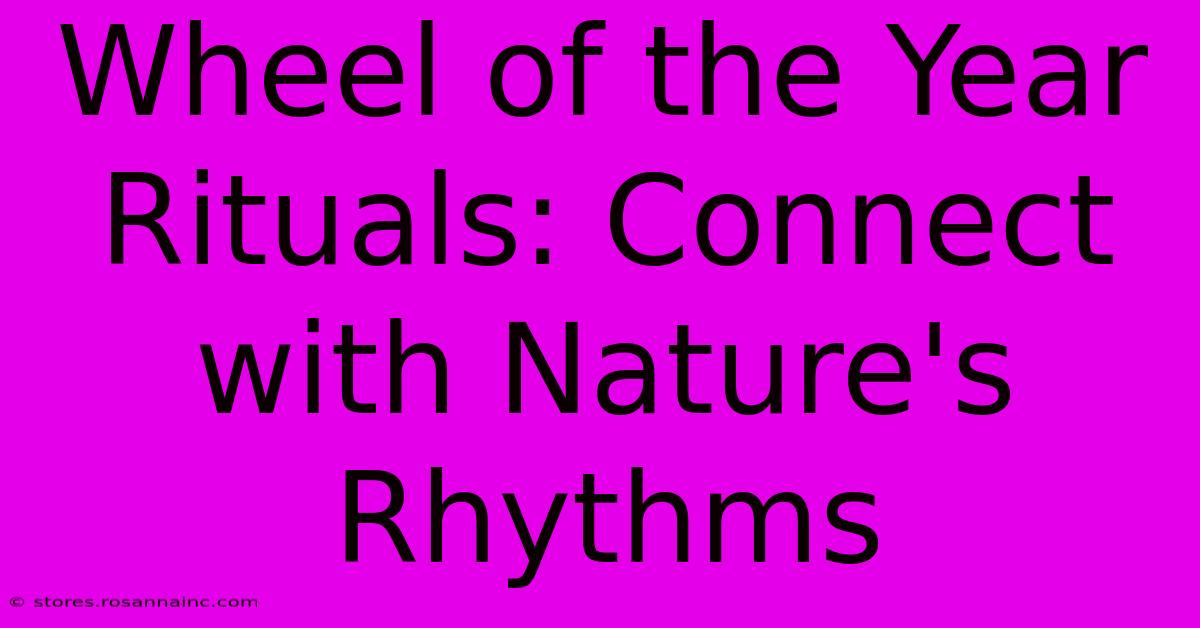Wheel Of The Year Rituals: Connect With Nature's Rhythms

Table of Contents
Wheel of the Year Rituals: Connect with Nature's Rhythms
The Wheel of the Year, a cyclical representation of the sun's journey and the changing seasons, offers a powerful framework for connecting with nature's rhythms and deepening our spiritual practice. This ancient system, rooted in pagan traditions, provides eight Sabbats – festivals marking significant turning points throughout the year. By participating in Wheel of the Year rituals, we can tap into the energy of each season, fostering personal growth and a stronger connection to the earth.
Understanding the Wheel of the Year Sabbats
The Wheel of the Year is not just a calendar; it's a journey of transformation. Each sabbat holds unique symbolism and energy, guiding us through a cycle of death and rebirth, light and darkness. Let's explore these eight sacred points:
1. Samhain (October 31st): The End and the Beginning
Samhain marks the end of the harvest and the beginning of the dark half of the year. It's a time for reflection, honoring ancestors, and releasing what no longer serves us. Rituals often include: creating memory altars, divination, and feasts. The essence of Samhain is about letting go to make way for new beginnings.
2. Yule (December 21st): The Winter Solstice
Yule celebrates the rebirth of the sun, the shortest day of the year. It's a time of hope, renewal, and the promise of returning light. Traditional rituals include: lighting candles, creating yule logs, and sharing stories. Yule symbolizes the potential for growth even in the deepest darkness.
3. Imbolc (February 2nd): The Awakening
Imbolc signifies the first stirrings of spring, a time of purification and anticipation. It's a period of cleansing and preparing for the growing season. Rituals often involve: making candles, spring cleaning, and planting seeds. Imbolc represents the awakening of life after winter's slumber.
4. Ostara (March 20th): The Spring Equinox
Ostara celebrates the balance between light and dark, marking the official beginning of spring. It's a time of new beginnings, fertility, and growth. Common rituals include: egg decorating, planting seeds, and celebrating the arrival of spring. Ostara symbolizes balance and the explosion of new life.
5. Beltane (May 1st): Celebrating Fertility and Passion
Beltane marks the peak of spring, a time of vibrant energy, fertility, and passion. It's a celebration of life, love, and abundance. Rituals frequently incorporate: Maypole dancing, bonfires, and handfasting ceremonies. Beltane is a vibrant celebration of life’s abundance.
6. Litha (June 21st): The Summer Solstice
Litha, the summer solstice, is the longest day of the year, a time of abundance and celebration. It's a peak of solar energy, a time to bask in the sun's power. Typical rituals might include: sun salutations, flower crowns, and bonfires. Litha embodies the height of summer’s power and energy.
7. Lammas (August 1st): The First Harvest
Lammas, the first harvest festival, celebrates the bounty of the earth's gifts. It's a time of gratitude and appreciation for the fruits of our labor. Common rituals involve: baking bread from the harvest, offering thanks, and creating harvest altars. Lammas marks the beginning of the harvest season, a time of gratitude.
8. Mabon (September 22nd): The Autumn Equinox
Mabon, the autumn equinox, marks the balance between light and dark, signifying the end of summer and the beginning of autumn. It’s a time of reflection, balance, and preparing for the coming winter. Rituals might include: creating corn dollies, releasing negativity, and reflecting on the past year. Mabon highlights balance and preparation for the coming winter months.
Creating Your Own Wheel of the Year Rituals
While traditional practices offer a rich foundation, the beauty of the Wheel of the Year is its adaptability. Feel free to personalize your rituals, drawing inspiration from nature and your own spiritual path. Consider these elements:
- Connecting with Nature: Spend time outdoors during each sabbat, observing the changes in the landscape.
- Symbolic Objects: Incorporate natural elements like flowers, herbs, stones, and candles that resonate with the energy of the season.
- Intention Setting: Set clear intentions for each sabbat, aligning your goals with the energy of the season.
- Mindfulness and Meditation: Use meditation or journaling to deepen your connection to the earth and your inner self.
- Community: Share your experiences with others, creating a supportive network of like-minded individuals.
By embracing the Wheel of the Year, you can cultivate a deeper connection with nature, deepen your spirituality, and live in harmony with the earth's rhythms. The journey is a personal one – let your intuition guide you as you navigate this ancient and powerful cycle.

Thank you for visiting our website wich cover about Wheel Of The Year Rituals: Connect With Nature's Rhythms. We hope the information provided has been useful to you. Feel free to contact us if you have any questions or need further assistance. See you next time and dont miss to bookmark.
Featured Posts
-
Ditch The Digestive Blues What Is Port Wines Secret
Feb 10, 2025
-
New Jeep Ad Features Harrison Ford
Feb 10, 2025
-
Colors Starting With A Design Secrets You Never Knew
Feb 10, 2025
-
From Pack To Puff Cigarette Count And Your Health
Feb 10, 2025
-
Unlock Downtown Nyc Your Dream Office At 120 Wall St
Feb 10, 2025
